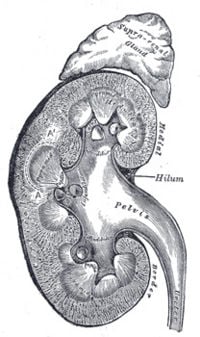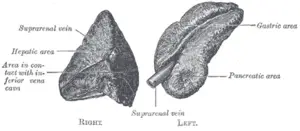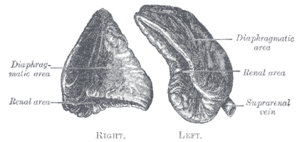Adrenal gland
In mammals, the adrenal glands (also known as suprarenal glands) are the triangle-shaped endocrine glands that sit atop the kidneys, as indicated by their name (ad, "near" or "at" + renes, "kidneys"). The adrenal glands are chiefly responsible for regulating the stress response through the synthesis of corticosteroids and catecholamines, including cortisol and adrenaline.
Overview

Anatomically, the adrenal glands are located in the abdomen, situated on the anteriosuperior aspect of the kidneys. In humans, the adrenal glands are found at the level of the 12th thoracic vertebra and receive their blood supply from the adrenal arteries.
The adrenal gland is separated into two distinct structures, the adrenal medulla and the adrenal cortex. Both structures receive regulatory input from the nervous system. The adrenal medulla takes up less than a quarter of the mass of the adrenal gland and is made of modified sympathetic ganglia. It is the body's main source of the catecholamine hormones adrenaline (epinephrine) and noradrenaline (norepinephrine). The adrenal medulla is at the center of the adrenal gland and is surrounded by the adrenal cortex, which forms the remaining three-quarters of the adrenal gland.
The adrenal cortex is divided into three layers, or zones. The zona glomerulosa is the outer zone and soley secretes aldosterone, a mineralcorticoid responsible for salt, water, and potassium regulation in the body. The middle zone, the zona fasciculata, secretes glucocorticoids. They increase the concentration of plasma glucose and are key in the natural stress response of the body. The zona reticularis is the inner layer and secretes mostly androgens. Some cells of the adrenal cortex belong to the hypothalamic-pituitary-adrenal axis and are the source of cortisol synthesis.
Blood Supply
Although variations of the blood supply to the adrenal glands are common, there are usually three arteries that supply each adrenal gland: the superior, middle, and inferior adrenal, or suprarenal, arteries.
Each superior adrenal artery, left and right, is a branch of the phrenic artery on that side of the body. The left and right phrenic arteries supply the diaphragm and come off the aorta. The middle adrenal artery is a branch directly off the aorta, while the inferior adrenal artery branches from the aorta or the renal artery.
Pathologies
Pathologies which occur with the adrenal gland can result in either excess production (hyper) or decreased production (hypo) of secreted hormones.
Hyperfunctioning States
Excess production of aldosterone from the zona glomerulosa is referred to as hyperaldosteronism. Symptoms include hypertension, muscle weakness, hypokalemia (low serum potassium), hypernatremia (high serum sodium levels), and associated metabolic alkalosis. Common treatment modality includes the treatment of the underlying cause, if any, and aldosterone antagonists, such as spironolactone.
Cushing's syndrome, or hypercortisolism, is an endocrine disorder caused by the presence of excessive levels of cortisol in the body. Common characteristics of the disorder include moon face, buffalo hump present on the back, and trunkal obesity. Other findings include hypertension, weakness, and osteoporosis. Some patients may present with glucose intolerance resulting in diabetes and also with emotional libility. Treatment involves resolution of the underlying cause, which may be medical or surgical.
Adrenal androgen excess is another example of a hyperfunctioning state. It is due to increase production of the hormones dehydroepiandrosterone and androstenedione, both which are precursors to testosterone. Signs and symptoms include hirsutism (excess body and facial hair), acne, and virilization (development of male secondary sexual characteristics). Adrenal androgen excess can be related with the secretion of other adrenal hormones and may present as a syndrome with some characteristics of Cushing's syndrome.
Hypofunctioning States
See also
- Fight-or-flight response
- Stress
ReferencesISBN links support NWE through referral fees
- Adrenal Gland, from Colorado State University
- MedlinePlus Encylopedia 002219
- Silverthorn, D. 2004. Human Physiology, An Integrated Approach (3rd Edition). San Francisco: Benjamin Cummings. ISBN 013102153
- Wilson, J. D., et al. 1991. Harrison's Principles of Internal Medicine (12th Edition). New York: McGraw- Hill, Inc. ISBN 0070708908
Template:Adrenal gland
| Endocrine system - edit |
|---|
| Adrenal gland | Corpus luteum | Hypothalamus | Kidney | Ovaries | Pancreas | Parathyroid gland | Pineal gland | Pituitary gland | Testes | Thyroid gland |
Credits
New World Encyclopedia writers and editors rewrote and completed the Wikipedia article in accordance with New World Encyclopedia standards. This article abides by terms of the Creative Commons CC-by-sa 3.0 License (CC-by-sa), which may be used and disseminated with proper attribution. Credit is due under the terms of this license that can reference both the New World Encyclopedia contributors and the selfless volunteer contributors of the Wikimedia Foundation. To cite this article click here for a list of acceptable citing formats.The history of earlier contributions by wikipedians is accessible to researchers here:
The history of this article since it was imported to New World Encyclopedia:
Note: Some restrictions may apply to use of individual images which are separately licensed.

